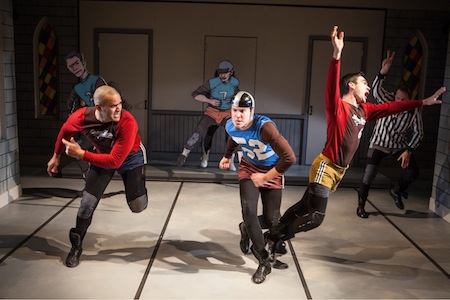Jam On
The Jammer
Atlantic Stage 2
330 W. 16th Street
New York, N.Y.

It's Brooklyn, circa 1958. The Dodgers have been gone for two years, Eisenhower is president and rock and roll music is sweeping the nation. It's nighttime at a local sports arena, time for outlandishly dressed men and women to crash over rails, leap over fallen skaters and elbow each other. It is time for fans to lose their sanity and yell and scream at the top of their lungs for the hometown team.
It is time for roller derby.
From the late 1940s to the early 1970s, the brazen men and wild women of roller derby were skating in smoky arenas all over America on wooden ovals in a frantic race for points and time. Teams from New York to San Francisco drew crowds as large as 50,000 fans at indoor and outdoor arenas and millions more watched on television.
The roller derby skating teams, with names such as the Jolters and Bombers, gave the country a very rowdy, fast paced sport, supposedly a little fixed at times. It was like professional wrestling, with roaring crowds, bigger than life stars and non-stop violence.
Roller derby faded in the 1970s, but it's become fashionable again these days, mixed with a healthy dollop of punk rock, feminism, and grrls.
The Jammer, a wonderful spoof of the colorful roller derby world of the 1950s, opened last week in New York. In the lobby, patrons could walk past walls filled with luscious 1950s roller derby posters and framed newspaper articles with photos of the helmeted warriors colliding with each other. Inside, they could cheer as, on stage, young Jack Lovington quit his jobs and joined the New York Brown Devils roller derby team and, with a wacky collection of teammates, skates his way into the hearts of Brooklynites, and audiences, in a very funny and very lovable play.
The lovable Jack, played well by Patch Darragh, is a simple man who has been engaged to his difficult fiancé for two years; the devout Catholics sleep in separate beds. He is madly in love with roller derby, though, quits his jobs and leaves town to tour with the team and chase the national championship.
Director Jackson Gay has created a marvelous roller derby world on stage. She has life-sized cardboard people cut outs, semi-completed buses and Coney Island roller coaster cars. Best of all, she has managed to recreate a portion of the old roller track and trained actors to simulate skating and elbowing (there is nothing more American than elbowing).
In the middle of all this, playwright Rolin Jones has weaved a story that fully utilizes a marvelous cast of characters that seem like they were yanked out of a 1950s paperback novel. They scream, they complain, they curse and they skate like mad as the team tours the country in a rickety old bus, battling teams from coast to coast with their helmets on and skates oiled.
Director Gay gets superb performances from her cast: Todd Weeks as Father Kosciusko, Greg Stuhr as Bert Fineberg, Keira Naughton as Beth Nutterman, Billy Eugene Jones as Lenny Ringle, Kate Rigg as Cindy Gums, and Jeanine Serrales as the sensational Linda Batello, Dan Domingues as Father Domingo and Christ Jackson as Charlie Heartbreak. Darragh is the multi-talented star.
The Jammer brings back memories. As a kid, I watched roller derby and professional wrestling all night on television. I liked the roller derby men because they spent the entire match trying to beat each other up, but I loved the women because they spent the match trying to absolutely kill each other.
Roller derby started to flourish in the 1930s. By the 1950s it had expanded to over fifty cities, several leagues, national and local, and was seen on dozens of local television stations. The peak years for roller derby were the early 1970s, when 19,000 fans jammed Madison Square Garden for an indoor match and 50,000 packed Comiskey Park in Chicago, for an outdoor match. But without a national television contract, high costs, the 1973 gas crisis and strong competition from other sports, roller derby died by the mid-1970s.
But it's back. The revival began in 2006 and now there are more than 400 small roller derby leagues in the U.S. and Canada, most of them all women. Just in New York, there are the Gotham Girls, Connecticut Roller Girls, Hudson Valley Horrors, Long Island Roller Rebels New York Shock Exchange and Suburbia Roller derby.
Young audiences will enjoy this funny play, but older audiences will love it. The comedy brings back memories of sitting on your couch, turning on television, chomping on a candy bar and sitting back to watch Roller Derby, with all of its thrills and spills.
PRODUCTION: Produced by the Atlantic Theater Company, Sets: Wilson Chin, Costumes: Jessica Ford, Lighting: Paul Whitaker Sound: The Broken Chord, Violence Consultant: J. David Brimmer
